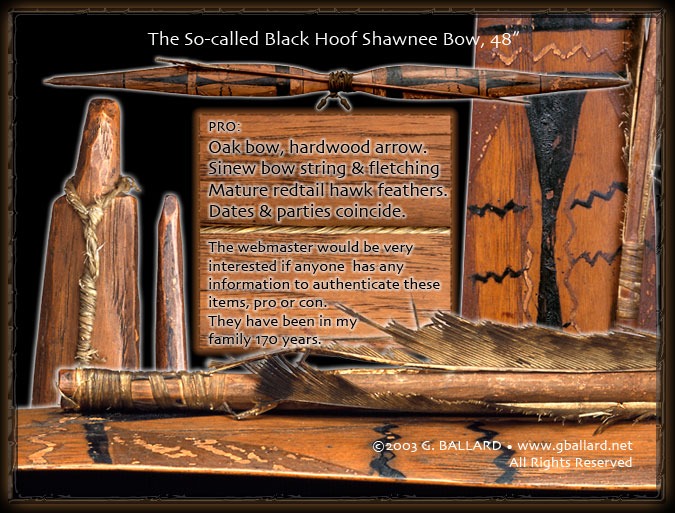Photo/design by Gary G. Ballard, San Diego |
|
 |
|
OLD ANTIQUE NATIVE AMERICAN BOW ARROWTwo North American bows aficionados have graciously took the time to write me regarding my request to authenticate this old bow and arrow. Both said it is an 1800s old MODOC Indian bow, and both dated it 1870s (40 years AFTER Blackhoof died!). What this means is either: 1) The history book is wrong, or 2) my ancestor was goofy. I am going to leave the jury out on this here based on: 1) what my grandmother, aunt and uncles told my family, and 2) I find it highly unlikely this bow style and motif did not exist prior to 1870 in North America. The photos I saw on the internet did however clearly indicate the bow and tribal motif are of known Modoc Indians origin, a northern California Indian tribe, but how the old Indian bow and arrow ended up in my family, and my ancestors' relationship to BlackHoof and the Shawnee people, are impossible for me or anyone else to verify - I've only written what my elders have told me. Please visit these links for more on the Modoc Indian Tribal history, and the Klamath Tribes, the Modoc Klamath Yahooskin Native American Indians, and "The Modoc Indians: A Native American Saga" by Cheewa James, Modoc Tribe of Oklahoma.
OLD AMERICAN INDIAN BOW: To learn more about Chief Black Hoof, please go HEREshelbycountyhistory.org, and HERErootsweb.com. My oral family history records the revered Shawnee war chief and statesman, BlackHoof, took personal interest in William Cochran and his son, James, and gifted this bow and arrow to James, in the mid 1820s, so James could participate in sports with Black Hoof’s grandsons. The bow and arrow and story have been in the family since.... The old Shawnee bow, old Native American Indian bow pictured here is 48-inches long and has been in my family over 170 years.
William Cochran and his family squatted the Defiance Trail, Auglaize River area in 1821, on the foot of the Great Black Swamp. This bow and arrow graphic is part of a 200-photo, 45-minute video documentary on one of the first white families to homestead northwest Ohio in the early 1800s, the Great Black Swamp, Defiance Trail, Auglaize River, Scott's Crossing, Lima, Elida, Delphos area. A 30-minute version of the documentary and more than 20 of the restored vintage 1800s 1900s historical photographs may be viewed HEREgballard.net The free on-line documentary also contains an in-depth 2002 interview of a 76-year-old elder woman which connects the Treaty of Greenville 1795, Indian Removal Act 1830, and Trail of Tears (late 1830s) to her family oral history. |
|
| Terms of Use • Privacy Statement • Site Map Kumeyaay Indians Home • About Us • Mission Statement • Press Kit • Contact Us |

